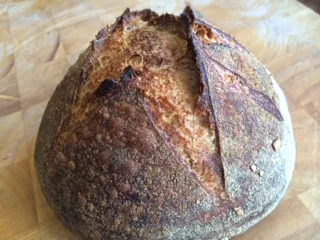
I was inspired by Syd's bake to try my first Pain de Campagne. I wasn't happy with the first bake, although my husband really enjoyed the taste and texture of the bread. It was extremely light and made great sandwiches. As I often do, I froze the other half of the dough to make at a later date, and I baked it today. As usual, my second bake from the frozen loaf turned out better than the first bake from fresh. The first loaf didn't get much height, but had good crumb. The second loaf had much better oven spring and more height. Both had excellent, tangy taste. I have made a crumb comparison between the two loaves below. The first crumb shot is from the fresh loaf; the second is from the bake today.
Crumb from the first bake.
Pain de Campagne (adapted from Syd’s recipe)
Levain
- 50g mature whole wheat starter (mine was mixed)
- 100g water
- 100g whole wheat flour
Allow to peak. This could take from 4-10 hours. Mine took 8 hours.
Main Dough
- 200g of the levain
- 350g water
- 50g rye
- 1/2 tsp diastatic malt powder
- 450g bread flour
Disperse the levain in the water with a wire whisk until there is a good foam on top. Next, whisk in rye and malt powder. Then add bread flour with spatula and mix until all the flour has been moistened.
- autolyse for 50-60 minutes
Then:
- add 10g salt
- knead to medium gluten development (if the dough is sticky, you can use your dough scraper. Try not to add more flour. Just enough for your surface and hands.
Now:
- bulk ferment for 1-2 hours with a turn at 30 minutes (I left the dough for 2 hours and turned twice).
Next:
- pre-shape
- rest 10 minutes
- final shape
Put into well floured banneton and after about half an hour cover and:
- retard for 12 hours in the fridge
- let the dough warm up just before the bake; you’ll see it rise a bit more
Bake
- at 500F in a covered baker for 30 minutes
Then:
- Remove the lid and reduce heat to 435 convection, baking for another 20 - 25 minutes
If you don’t have a covered baker (Syd’s original instructions):
Bake
- at 230 C with steam for 15 minutes
Then:
- reduce heat to 200 C and bake for a further 30 - 35 minutes
The proportionately large amount of levain in this recipe means that the dough develops really quickly hence the relatively short bulk fermentation time.

- CAphyl's Blog
- Log in or register to post comments
Very nice!
We really enjoyed it! Best, Phyllis
Phyllis,
I love the volume and height you have achieved with your second bake. The crust color and blistering are awesome too. I am intrigued as to why you are getting these differences between the frozen and unfrozen dough. On your first bake you got smaller, more evenly spaced pores in your crumb, however, on your second bake you got larger, more irregular holes. The crumb structure is probably easier to explain than the height/volume discrepancy. I can imagine some larger gas pockets being left behind after shaping stiff, just thawed out dough. It is can be quite difficult to shape. However, it almost seems as if the gluten is tightening up during it's sojourn in the freezer and enabling you to get a better height. Perhaps some more experimentation is in order.
Nice baking Phyllis,
Syd
On the second bake, I did a few things differently. I think on the first bake, I took the banneton out of the fridge too early, and it actually over-proofed. Today, I took it out just as the oven was pre-heating. The dough was still pretty cold when I popped it into the pre-heated LaCloche covered baker. I scored it and sprayed it with just a bit of water before putting it in the oven. The colder dough really popped up in the oven nicely. I agree that more experimentation is needed! Thanks again for the great recipe, encouragement and support! Best, Phyllis
Very nice bake Phyllis.
Very interesting about your experiments with the frozen dough and kind of a mystery.
Curious to read about your further experimentation.
Regards,
Ian
One other thought I had about freezing the dough and getting more height is that I usually do a couple of stretch and folds once the dough thaws and that may give it a bit more structure. For this particular dough, I did not want to over handle it or get it too warm, so I did the stretch and folds when the dough was pretty cold and then put it in the fridge overnight. It didn't look like it proofed much at all, but then it popped in the oven. Who knows?! I will keep experimenting. Best, Phyllis
at how well your frozen 2nd loaf comes out My freezer is full of baked bread so no room for the unbaked ones. Love the crust on this one. Baking boldly is the way to go. This bread has to taste great too.
Well done and happy baking Phyllis.
dabrownman: We are really enjoying the breads more with the bold crust, so I will continue to bake this way. This particular recipe was so light; my husband commented a few times how much he enjoyed the taste and texture. I still would like to get more lift out of starter, however. Not sure I am "renewing" it enough. The only bread I was happy with the proof cycle recently was the rye seeded I adapted from Khalid's recipe. It's always fun to keep trying. Thanks for the advice and support. Best, Phyllis